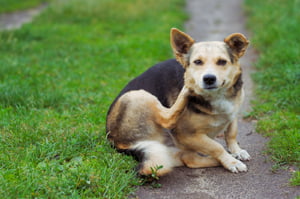Nothing can drive a dog owner crazy more quickly than a dog with behavior problems. Dog owners want their dog to be healthy and happy, but a dog must also be well behaved and disciplined in order to fit into the family structure.
Well behaved dogs and puppies make owners, neighbors, and family members happy. Unruly puppies and dogs that run amok jumping on people, barking with the slightest provocation, constantly scratching, gnawing on furniture, and begging for food can get annoying even for the most ardent dog lover.
As a dog owner, you can learn to identify and address your dog or puppy’s behavioral problems and correct them. The sooner you take corrective action for your dog’s behavior problems the sooner you and your pet will be happier.
How do I stop my dog from jumping on people?
I love dogs, but I don’t like for my Golden Retriever to jump on me after she has been running through the wet grass or mud. It seems inevitable that when a dog jumps on you they have been running through some kind of muck, and you are usually dressed in your best clothes.
Small dogs often have sharp claws that can scratch your legs or run women’s hosiery. Large dogs that jump on people uncontrollably not only ruin clothes and annoy people, but if the behavior is not corrected they may jump up on children and unintentionally knock them down.
Train your dog not to jump on people. This behavior problem can be solved by teaching your dog simple manners and obedience. Chances are that you have unwittingly rewarded your dog for jumping up to greet you by petting him and speaking to him in a positive manner. The first thing you can do is make sure no one rewards your dog for jumping up to greet them. Explain that you are training your dog, even to dog lovers who tell you they don’t mind your dog’s jumping.
In order to maintain the alpha position in the family pack try to minimize your arrival home. Dog trainers recommend that during training you not greet your dog for about fifteen minutes. This makes your arrival home less dramatic and exciting, which are prompts for your dog to jump up and greet you.
When you do greet your dog, bend over and pet him at his level. This keeps him from having to jump to get to you.
Finally, teach your dog “sit” and “off” commands. To ensure that your puppy or dog relates the “off” command to their jumping behavior you must issue the command immediately once the dog jumps, whether on yourself or others.
My dog barks all the time.
Barking is instinctual for dogs. You probably want your dog to bark when strangers are lurking nearby or they hear a noise that is out of the ordinary. Some dog breeds have been bred to bark as watch dogs or herd dogs. On the other hand, constant yapping can get on any dog owner’s nerves.
Train your dog not to bark inappropriately. If you find your dog is barking excessively, it is important to assess the reasons why your dog may be barking. It is appropriate to bark when startled, responding to other dog barks, or alerting you of anyone approaching your home.
Most often inappropriate dog barking is the result of boredom, attention getting behavior, or excessive energy. Each of these causes of barking behavioral problems can be addressed so that you can help your dog relax and spare the barking.
The most important aspect of training a dog not to bark is to learn not to yell. If you yell at your dog they may think you are only joining in the game of barking. A firm, one word command, such as “enough” should be used to train your dog to stop barking.
Training a bored dog not to bark will require proactive solutions on your part. You or other members of your family will need to spend time playing with the dog. Teach the dog to play fetch or play tug-of-war with your puppy’s favorite rope toy.
It is extremely important that your dog have enough time to play outside, run, and bark. I highly recommend that all dog owners have a fence that will accommodate the needs of their dog. The dog’s ability to run and play will help expend some of the energy and excitement that they put into constant barking.
Why does my dog scratch and gnaw at her skin?
Skin irritation on your puppy or dog can contribute to the annoying behavior of constant scratching and gnawing. Some dog breeds have more sensitive skin than others, but some dogs develop a habit of gnawing at themselves out of anxiety.
It’s difficult to peacefully co-exist with a dog or puppy that is constantly gnawing or scratching. It’s probably just as difficult for the dog.
Help eliminate the problem of your dog’s constant scratch or itch. It may be necessary to consult a vet to find out the reason that your dog is constantly scratching. Likewise, it may be as easy as identifying critters that are biting your dog, such as fleas or even mosquitoes.
If your vet identifies a skin allergy, common in the south according to our vet, it may be necessary to administer an antihistamine during breakouts to prevent scratching and gnawing can make the problem worse or even lead to infection and fur loss.
Keeping your yard and your pet’s environment clean will help eliminate mosquitoes and other pests. Make sure that your pet has fresh water, as standing water is an invitation for mosquito eggs.
Topical analgesics, that are not harmful to your pet if ingested, can also help eliminate itch. We have successfully used Benadryl spray on mosquito bites and other unidentifiable bumps and breakouts.
We have also had to turn to the vet when a particular rash began to spread and seemed to drive our Retriever to want to gnaw and scratch all the time. A monitored dose of prednisone and antihistamine helped alleviate the rash, inflammation, and itch.
My puppy will not stop gnawing on the furniture.
Puppies are most often blamed for gnawing on furniture and everything else in sight, including shoes, books, and, yes, even homework. Actually, growing dogs that are no longer puppies may also go through phases of gnawing and chewing.
Obviously, puppies are chewing because they are cutting teeth. Older dogs may chew for other reasons. Our Golden Retriever loves the texture of sticks, prefers them to dog biscuits and all manner of dog toys. The problem is we can’t allow her to mulch sticks in the living room every evening.
Some dogs chew simply for pleasure or out of boredom.
How to keep your dog from chewing furniture and other inappropriate items. First and most importantly, spend time with your dog so that he or she feels your companionship and care. Spending active time with your dog will keep her from getting bored and resorting to chewing for entertainment.
In order to keep your dog from chewing on furniture while you are away apply a material like “Dog Be Gone” or some other deterrent to keep dogs away from furniture and other items they are not allowed to chew on.
Provide a variety of toys that are sturdy and in a diverse collection of textures. This will help give your dog something on which to chew without getting in trouble.
As with all other problem dog behaviors, you will have to use the “no” command immediately when you catch your dog chewing on forbidden objects. If you are not home to catch her, then keep the objects put up until you are home to deal with your dogs chewing on these items.
If necessary, keep your dog outside, in a fence, during the day with plenty of water and toys to help keep her occupied. This will keep her away from your furniture and household items while you are away from home.
How can I stop my dog from begging?
Dogs and puppies only learn to beg when they are fed from the table. Once they are fed something other than dog food, they know when you are eating and usually would like for you to share. The best way to keep your dog or puppy from the bad behavior of constantly begging or whining for food is not to teach them to do it in the first place.
If someone in your home slips human food to your pet, that is the person you must train. It is in your dog’s best interest that they not develop a taste for food other than that formulated especially for them. It is not healthy and can contribute to obesity.
How to stop your dog from begging. If your dog is already begging first, stop feeding the dog from the table. Second, use a firm “enough” or “no” command to let your dog know he or she will not receive food.
You may have to endure whining and barking, but it is important that the reward for begging is cut off immediately, and that it remains cut off consistently. This means that everyone must understand that no one is to respond to begging behavior.
If one person isn’t on board, your dog will be confused or at the very least continue to go to the feeding culprit to beg because the dog or puppy knows the behavior will be rewarded.
If necessary, put the dog in his crate or outside during mealtimes.
Set a feeding time for your dog, usually one in the morning and one in the afternoon, and stick to it. Help your dog learn that there is an appropriate time set aside to eat.
Get the family on board to improve dog and puppy behavioral training.
For you to successfully train your dog, your family and friends must understand that the dog or puppy is in training. Their participation and use of common commands, in the same manner you use them, is essential to the dog’s ability to learn manners and obedience. Explain to friends and family that you need their assistance to help curb annoying or bad dog behaviors, and you will likely find them more than happy to help.
Sources:
Advice About Dogs Chewing Furniture, dog obedienceadvice.com
Dealing with Dogs that Beg, Petplace.com
Excessive Barking: A Common Behavior Problem, peteducation.com
How to Stop Your Dog Jumping, Dogobedience.com
Personal Experience
Put a Stop to Dog Scratching and Gnawing



